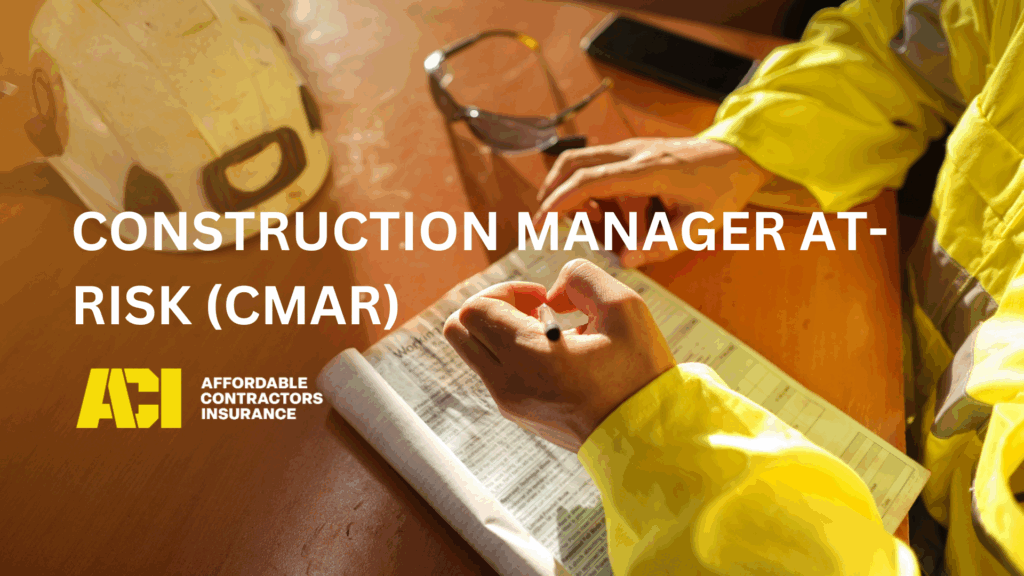CMAR Delivery Method

Construction manager at-risk (CMAR) is a type of delivery system for construction management skills. The name comes from the fact that in this delivery method the construction manager partners with the owner.
Because of that partnership, the construction manager must design and manage all phases of the process from inception to completion with the overriding concern of what benefits the owner the most. This means that the construction manager must strictly monitor the following elements of a CMAR project:
Guaranteed Maximum Price (GMP)
GMP in construction refers to the fact that from the onset of the project, the manager has agreed that the project will be completed at a price that has been guaranteed by him to the owner. The GMP works well in the design phase, but as a project progresses, the chance for overruns increases. More factors evolve, which the construction manager has less control over. Some of those factors are the following:
Performance
Workforce performance is a familiar responsibility for a construction manager. However, ensuring that each worker performs to the high standards set for a construction manager at-risk project is no easy deal. Getting excellent performance out of workers can be an uneven process in which the standards exceed the capability of some individual workers. Remedying that may not be a quick fix, and in the case of sub-contractors, they may not want to comply with those elevated demands.
Financial Stability
Financial stability is a key factor in a construction manager at-risk project because it is so long and drawn out. The process can last six to eighteen months, meaning construction manager needs to have the financial resources to sustain a project of that length. On the flip side, an owner has committed to a monetary payout: the GMP. That owner must be able to come up with that sum of money when the project is completed.
Costs
Cost overruns are a familiar dilemma for a construction manager. However, with a CMAR delivery method, it’s not an easy fix. Accelerated costs can come from many routine sources. The cost of materials can go up. Vendors and sub-contractors may demand more money. With a GMP, the construction manager is restricted on how he is going to pay for these unexpected costs. This limitation on funds is where CMAR contract agreements lack the flexibility needed in an unpredictable business like construction.
Scheduling
Tight deadlines are a reality for construction manager working throughout a CM-at risk proposition, However, delays are inevitable. It can be a hurricane in Miami, scorching temperatures in Phoenix or the inclement weather that’s routine in the Mid-West, Northeast or Northwest. Late shipments of materials and worker injuries can compound construction delays. The construction manager must deal with all these unforeseen situations and still stay on track to meet the deadline.
Quality
Owners opt for CM-at risk agreements in lieu of the lowest bid selection. That is because owners want a high quality outcome from the construction manager, who is overseeing a large and very complex project. Sustaining that high quality is a formidable challenge for the construction manager because of the length of time that most CM-at risk projects take. If the construction manager doesn’t meet those quality standards, he could be in default.
Summary of CMAR Pros & Cons
Pros:
- Owner Partnership: The construction manager works closely with the owner, ensuring the project is designed and managed with the owner’s best interests in mind.
- Guaranteed Maximum Price (GMP): The construction project cost is capped, offering the owner financial predictability and minimizing cost overruns.
- Better Quality Control: Owners often choose CM-at-Risk for complex projects where high quality is a priority over the lowest bid, leading to better outcomes.
Cons:
- Cost Overruns: Although the GMP offers some protection, unexpected costs like rising material prices or delays can put pressure on the construction manager’s budget.
- Performance Risks: Ensuring all workers, including subcontractors, meet the high standards of a CM-at-Risk project can be challenging and may lead to delays.
- Limited Flexibility: The guaranteed cost structure can limit the construction manager’s ability to adjust to unforeseen changes during the project.
The Role of Insurance in CM-at-Risk Projects
In CMAR projects, insurance plays a crucial role in protecting both the construction manager and the owner from unforeseen risks. Since these projects often involve long timelines, cost overruns, and potential delays due to external factors like weather or supply chain disruptions, having the right insurance coverage is essential.
General liability insurance, builder’s risk policies, and coverage for equipment and workers help safeguard against financial loss and legal issues. Proper insurance ensures that both parties can mitigate risks and move forward confidently, even when challenges arise during the project.
Reach out to Affordable Contractors Insurance today to see how our agents can assist you in making sure you’re prepared to tackle CMAR delivery method!